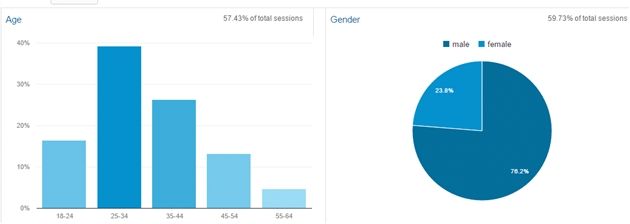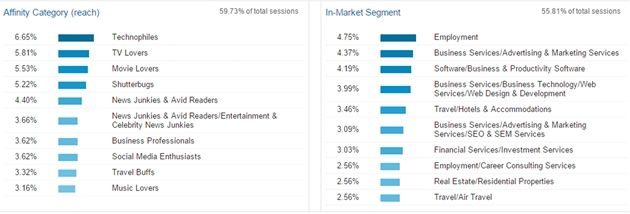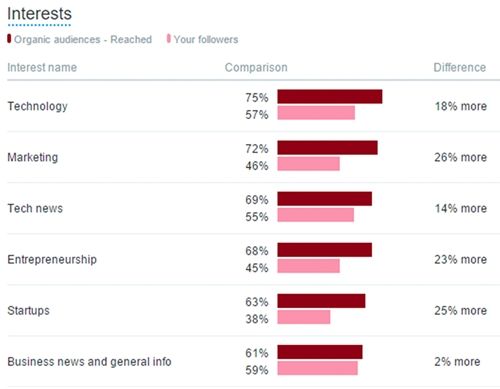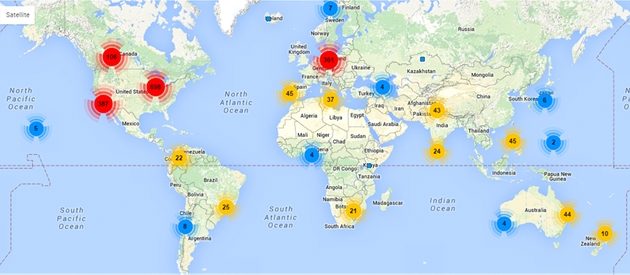Sarah wakes up at precisely 6:43 AM. She proceeds to hit the snooze button until 7:03, when she rolls over and beings scrolling through a news app on her iPhone 6.
By 7:15 she's in the shower singing that Adele song she can't seem to get out of her head.
At some point between 7:15 AM and the end of the day, she buys your product.
Whether Sarah sang Adele or Taylor Swift in the shower that morning probably didn't have any bearing on her decision to make a purchase from you that day.
So what did?

In the B2B space, where you have multiple stakeholders involved in purchasing decisions, the answer to that question becomes even more complicated—and even more important to figure out.
Knowing what motivates your customers' purchasing decisions is essential for building a successful inbound marketing campaign. Marketing to the wrong person could mean your content isn't getting in front of the eyes of the people who might actually buy what you're selling.
How do you figure out what motivates your potential customers to purchase? By creating buyer personas.
Buyer personas can be a huge boon to your business—as long as you know what information to collect and how to use it. Here are just a few ways buyer personas can help with your B2B marketing efforts:
- Better target and promote your content
- Speak the "language" of your most likely customers in your marketing materials
- Gain better-quality leads
- Tailor sales pitches
- Inform product development
Whether you're a beginner who's just starting to explore your marketing options, or a seasoned marketing veteran looking to revisit your strategy, buyer personas are a great place to start.
If you want to start fleshing out your buyer personas, don't get bogged down in unnecessary details (like their shower-song preferences). Instead, start by focusing on demographic data and major motivators.
A lot of that information is likely already at your disposal, and this handy guide will show you how to access it.
1. Start with the basics
Who is actually in charge of making the purchasing decisions in your industry? If you think you already know the answer, give it another thought. Because answering that question incorrectly will render the rest of this exercise, and your inbound marketing, pointless.
In B2B, there are most likely multiple people involved in making the decision to buy your product or service. The CEO might be the one pulling out his credit card, but he is probably not the one who did the initial research.
Nearly half off all B2B researchers are millennials, and they are not in C-suite level positions, according to a 2015 Google study. In fact, 81% of non-C-suite-level employees have some say in purchase decisions.
If you are marketing only to senior-level executives in your industry, you are not going to be very effective. You need to create a strategy to target everyone with a say in the purchasing process.
Accordingly, you will need to create separate buyer personas for each category of person involved in purchasing decisions in your industry. From CEOs to engineers, researchers, and anyone else involved in the buying process.
But, to complete this exercise, pick one persona and stick with it. Eventually, you will have to repeat with the rest, so it doesn't matter which one you start with. Follow your heart, and let's get started.
2. Interview an actual person
The fastest way to get to know someone is to actually talk to them. Simple enough, but many people do not like, or are genuinely scared of, talking on the phone. Get over that fear and pick up the phone.

Once you've chosen which persona you want to focus on, it should be easy enough to find a real life example of that persona.
The easiest place to start is with your own customers. You can bet that someone who has already purchased from you will have some insights about what went into that choice. If you have a longtime customer you have a good relationship with, consider reaching out to that person rather than a new customer.
Keep in mind that it may be more difficult to find someone involved earlier in the buying process, like a researcher. You may have to ask someone higher up to direct you to someone.
If you are a new company and are just starting out, you will have to get more creative to find an interviewee. Use your network of coworkers and friends in your industry to see whether they might have any leads. You can also search by job title on LinkedIn for people you have a common connection with.
Once you have selected someone to interview, don't just call them out of the blue. Email them ahead of time and ask them to block some time out in their schedule. No one likes unsolicited phone calls, and you don't want the conversation to be rushed.
Though it may be tempting to just email a list of questions and ask the interviewee to email them back, you will benefit much more from getting on the phone. A call will allow them to speak more off the cuff and give you a better sense of their personality.
Before calling, prepare a list of questions to ask. You can find a ton of great interview questions for buyer personas with a simple google search. I like this list from HubSpot, but there are plenty of others.
When talking to your interviewee, start with more broad demographic questions, then move on to asking more abstract questions about their challenges and goals.
The hardest part of an interview is balancing collecting valuable information with not getting distracted by unimportant details (remember Adele vs. Taylor Swift?).
One trick is to listen for keywords and themes that repeatedly come up. Jot those down on a separate sheet of paper.
For example, if interviewees mention how they like to start their day by eating a healthy breakfast while browsing the tops stories on Flipboard to keep up with the latest news in their industry, the important thing is not the healthy breakfast or morning routine. What you should take away is that they like to be informed on happenings in the industry.
3. Use Google Analytics data
Interviews are helpful for determining key themes and motivators, but they can be biased because you are getting only one person's view. Although you could conduct hundreds of interviews and average out the data, it would be too time consuming to be worth it.
If you have Google Analytics setup on your company's website, you already have a treasure trove of demographic information just waiting for you to access. (If you don't have Google Analytics set up, I highly suggest you start right now.)
Google Analytics works best for finding demographic data. To get started, open up the Audience tab. From there select Demographics and then Overview. This view will give you a quick and simple analysis of the average age and gender of your visitors (make sure your date is set as far back as possible, so you are seeing all historic data).

You can also learn general information about your persona's interests from Google Analytics. Below demographics, select Interests and then Overview.
The interests section will show you all the affinity categories you might use to reach your customers. Customers in these categories are in the top of your purchase funnel and they are just beginning the process.

You can go into a lot more detail for each of these interests (by looking at individual sessions and conversion rates) but all you need to get from this report at this point is their general interests categories.
4. Use social media data
Another treasure trove of information already at your disposal is your social media data. (If you are not already using social media to market your business, you should probably change that.)
Social media data is helpful for understanding your customers. By knowing what they talk about and how they interact online you can better craft your messaging to reach and appeal to them.
It will also give you more information about their interests than Google Analytics because they tend to talk about personal preferences on social media.
For example, Twitter's analytics allows you to see what your followers' unique interests are. Simply sign in to the analytics dashboard with your Twitter profile and turn it on to get started.
The homepage will show you a summary of your impressions and mentions, but you'll want is to select the Audience tab. Under the audience insights section, you will see a breakdown of your followers' top interests.
You can change this to show you the interests of your organic audience or even all of Twitter's users. You can even compare these data sets against each other to see how they stack up.

You can also use a tool like Followerwonk to analyze your follower's bios and learn even more about them. It will show you not only where they are tweeting from but also at what times, helping you make sure you are tweeting at the optimal time for your audience to see you.

My favorite way to use Followerwonk for developing personas is the word cloud of the most frequently occurring words in your followers' Twitter bios. Those bios are important because they are how your followers choose to describe themselves.

Another great source of social media data is LinkedIn, where you can actually use the information you gained from Twitter to find out more about your personas: The frequently occurring words you found in your followers' Twitter bios give you great insight into your personas interests. Use those interests to find related LinkedIn groups.
For example, if your persona is interested in digital marketing, you will find numerous LinkedIn groups full of people with a range of job titles who are sharing information relevant to that industry.
Find a group with high engagement (lots of likes and comments on shared content). Visit that group to see what kind of content is popular. You can use that to inform your future content ideation.
5. Get psychographic
By this point in the process you've figured out your persona's age, gender, and interests, but you're still missing an important piece: the psychographic profile.
You need to have both demographic and psychographic data for your personas if you are to effectively target buyers. Demographics may tell you who your buyer is, but the psychographic profile tells you why they buy. Using both is important to create a fleshed-out buyer persona.
The psychographic profile is more difficult than the demographics because it is a lot more speculative. You should base it on your initial research, but a lot of it will have to come from educated guesses.
For example, here is some of the demographic data you may have collected about your persona:
- Male
- Age 35-45
- Married, has children
- Interested in technology, marketing, startups, entrepreneurship
- Loves travel, is a news junkie and audiophile
From that information (using key themes you wrote down earlier on in your interviews) you may be able to extrapolate the following about your persona:
- Struggles with work/life balance, time management
- Values family time
- Fulfilled by career success
- Concerned about the economy
- Values quality over quantity
If you know that your buyer persona is interested only in marketing and startups, you might find yourself writing generic content about marketing tips for small businesses. With your psychographic information, however, you can write content about software that helps with time management, travel destinations for families, or the best technology for the workplace.
If you're struggling to find the connection between your demographic and psychographic profiles, Chelsea Baldwin from Copy Power has a great technique. (I will summarize it here, but you can read the post on her blog.)
Here is the (deceptively) simple framework she lays out:
- Think about your company and why your founder started it. Ask yourself: Why do they show up every day? Why do they do what they do?
- Ask yourself why you do what you do. Why do you love it? Why did you seek out this company?
- Now ask these same questions about your buyer. Why do they do what they do? What makes them excited to show up to work every day?
Take all of your answers to these questions and highlight the similarities between them. These similarities are what motivate your buyer, and they should become the basis of your psychographic profile.
6. Add a face and a name
At this point you should have just about all the information you need about your buyer persona. Before you call your persona all good and done, there is one final step to really tie all the pieces together: Give the persona an identity!
Naming and picking out a photo to act as your buyer may sound a little pointless and cutesy, but it really does have a purpose. It will help you visualize your persona and make him/her less abstract.
If you have multiple buyer personas, giving them identities will also help you keep them straight. Rather than Buyer Persona 1 and Buyer Persona 2, you might have Software Sam and CEO Sally.
When picking a name, I like to use something that describes job title, such as my CEO Sally example. It will help with clarity and organization.
When picking a photo for your persona, I suggest you have a little fun with it. Who doesn't love looking at weird stock photos?

After you've had a good laugh with your coworkers, try to pick a photo you can take seriously. A simple headshot of someone who fits your demographic data works best. Now your persona has a name and a face.
Now take the next step
You did it! You made a buyer persona! Now you might be wondering, What next?
The biggest mistake you can make at this point is to file your persona away somewhere and forget about it. Don't think that just because you went through the process of creating it, it will somehow magically change your marketing efforts.
If you want to start using your personas to improve your inbound marketing, then make them central to your marketing efforts.
Collect all of your information into a report and print it out. Keep a copy on your desk and make sure everyone involved in your marketing has a copy.
Refer to your report whenever you create content. Ask yourself why your personas will click on it, how they will use it, if they will share it, so on.
Do this... and prepare to watch your inbound marketing efforts succeed.
How do you use buyer personas in your business? Is there a tool you use to collect data I missed here? Let me know in the comments or tweet me at @carlyobscura.




